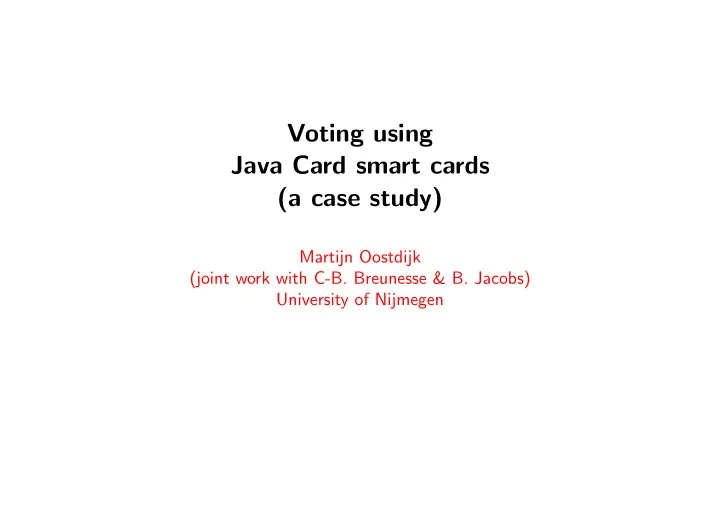

Voting using Java Card smart cards (a case study) Martijn Oostdijk (joint work with C-B. Breunesse & B. Jacobs) University of Nijmegen
Outline 1. Context 2. Toys & Setup 3. Voting 4. Implementation 5. Demo 6. Results & Conclusions
Context • Loop Group: Traditionally, interest in program correctness, semantics, logic • Semantics of Java in PVS theorem prover implemented in Loop Tool • VerifiCard: Application of Loop Tool to smart card application • Case study driven research • Problem: No experience with smart card applications • Security is interesting
Toys Schlumberger Palmera (10x) Gemplus GemXPresso IS (2x) Java iButton (+ adapters) (20x) Gemplus GCR410 (2x)
Setup Linux machine with Sun’s Java SDK and additional APIs, smart card terminal attached to serial port: APDUs Applet Host Application OCF API Java Card API JavaComm API RXTX
Why voting? Electronic voting is an interesting case study because: • Many aspects of security involved: − Confidentiality − Authentication − Integrity − Non-non-repudiation • Distributed application over the Internet • Untrusted clients: Smart cards as TCB
Voting 1 Applet Host Application Internet Server virus pubS privS pubA id v vote privA thread m s GUI id ‘‘Secure’’ feedback channel Personal vote list Voter
Personal vote list Stemnummers voor id pvda 227 vvd 72 cda 242 d66 16 groenlinks 235 sp 96 christenunie 83 sgp 46
Voting 2 • Applet A sends id to host application H • H sends vote v to A • A returns RSA/SHA signature s of v (using priv A ) • H generates a new session key des, encrypts it with pub S , and sends it to S • H sends ( id , . . . , v, s ) encrypted with des to S • S checks the signature
Voting 3 1. A → H : id 2. H → A : v 3. A → H : { ∂ ( v ) } priv A =: s 4. H → S : { des } pub S 5. H → S : { id , . . . , � v � s } des =: m 6. S → H : ack / deny
Implementation • Loading the applet onto the card: Visa OP • Generating the keys pub A and priv A • Initialization: INS_SET_ID , INS_SET_PRIVATE_EXP , INS_SET_MODULUS • Voting: INS_GET_ID , INS_SIGN • Terminal uses threads to keep GUI responsive
Implementation: process method ... case INS_SET_MODULUS: if (modulus!=null) ISOException.throwIt(ISO7816.SW_CONDITIONS_NOT_SATISFIED); else { modulus = new byte[lc]; readBuffer(apdu,modulus); } break; case INS_SIGN: if (modulus==null || private_exp==null) ISOException.throwIt(ISO7816.SW_CONDITIONS_NOT_SATISFIED); else sign(apdu); break; ...
Implementation: sign method MessageDigest digester; Cipher encrypter; ... byte[] buffer = apdu.getBuffer(); short lc = (short)(buffer[ISO7816.OFFSET_LC] & 0x00FF); if (lc!=BLOCK_SIZE) ISOException.throwIt(ISO7816.SW_WRONG_LENGTH); readBuffer(apdu,plaintext); digester.doFinal(plaintext,(short)0,BLOCK_SIZE,hashtext,(short)0); Util.arrayCopy(hashtext,(short)0, paddedhashtext,(short)(BLOCK_SIZE-hashtext.length), (short)hashtext.length); encrypter.doFinal(paddedhashtext, (short)0,BLOCK_SIZE,ciphertext,(short)0); writeBuffer(ciphertext,apdu); ...
Problems/Results • Crypto export restrictions: Sun’s JCE doesn’t come with RSA • Differences JC 2.0 and 2.1: iButtons use crypto processor directly • Threaded terminal: Correct? Not part of TCB • Patent pending for personal vote lists
Conclusions • Even though it’s Java, it’s still very low level • Applet is small enough to be formally specified • Security verification requires higher level reasoning? • Future work: Visa OP, GSM, other case studies...
Recommend
More recommend